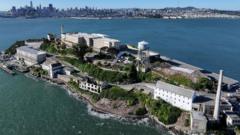**In a bold assertion, President Trump has revived interest in the infamous Alcatraz prison, suggesting it might house dangerous criminals again. Yet, experts point out the overwhelming logistical challenges.**
**Trump’s Alcatraz Revival: A Dream or a Distant Reality?**

**Trump’s Alcatraz Revival: A Dream or a Distant Reality?**
**Amidst rising crime concerns, Trump's proposal to reopen Alcatraz as a prison faces skepticism from experts.**
US President Donald Trump is once again creating headlines with his provocative proposal to reopen Alcatraz, the historic prison island that has been dormant for decades. Located in the San Francisco Bay, Alcatraz, once infamous for its high-profile inmates including Al Capone and George Kelly, now serves as a major tourist attraction with millions visiting annually. Trump has pitched the idea as a means of bolstering law and order in America, but experts are dismissing the plan as impractical.
Originally constructed as a military fort and then converted to a federal penitentiary in the 1930s, Alcatraz was shut down in 1963 due to its exorbitant operational costs which were nearly three times higher than other federal facilities. Currently, the site is managed by the National Park Service, attracting over 1.4 million visitors a year who come to explore its storied past.
While Trump's interest in repurposing the site isn't entirely novel—previous administrations have contemplated the idea—his recent comments have ignited fresh debates. He emphasized the prison as a 'symbol of law and order,’ stating that “for too long America has been plagued by vicious, violent, and repeat criminal offenders.” However, he also acknowledged the facility's dilapidated state, describing it as a “big hulk” that is “rusting and rotting.”
Trump's team, including border czar Tom Homan, supports the notion of reviving Alcatraz for housing dangerous offenders, a concept articulated in a post on Truth Social where Trump mentioned his directive to look into reopening and expanding the prison. A spokesperson from the Justice Department claimed efforts were underway to rehabilitate the site and restore it as a functioning facility.
Despite these assertions, significant skepticism remains among prison experts and historians. Hugh Hurwitz, former acting director of the Bureau of Prisons, expressed disbelief in the viability of the project, highlighting critical issues such as crumbling infrastructures and severe lack of essential security features. Jolene Babyak, a historian and former Alcatraz resident, pointed out that current sewage and water disposal methods would render the idea impractical.
Cost is another insurmountable factor. Running Alcatraz, which housed around 340 inmates at its peak, could result in exorbitant expenses, with estimates suggesting a possible per inmate cost soaring over $500. This excess cost stems from logistical challenges associated with supplying food and necessities to an isolated location.
With the complex problems surrounding Alcatraz's physical state and the financial implications, experts conclude that Trump's vision of reopening this iconic facility stands little chance of materializing. As history teaches, the allure of Alcatraz may garner the imagination, but restoring it as a prison seems far beyond reach.




















